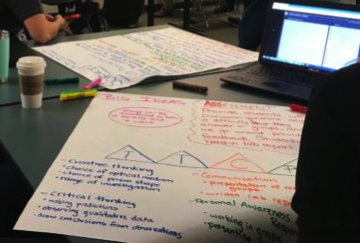Sense-Making Takes Time
Day 13 (of 187) – September 20, 2018

Wow. What an impressive crew… Secondary Year 1 at UNBC School of Education. This is my EDUC 360 class. I see these guys most often and I am really enjoying teaching this course, “Curriculum and Instruction: Introduction.” What we are working through is BC’s New Curriculum… but WORKING BACKWARDS. We started the course talking about curriculum development and theory then complimented this reading with the Heart of a Teacher. Parallel to this learning, along with the other coursework they are also engaged in, we are learning about BC’s New Curriculum and learning how to lesson/unit plan.
The class was sub-divided into self-identified subject specialities: Social Studies (top photo), English Language Arts (middle photo), and Science (bottom photos). Each group was asked to think of a learning activity they remembered from their K-12 learning experience to develop a lesson plan… WHAT DOES IT LOOK LIKE. Once the groups mutually agreed upon a lesson plan, they were asked to describe this learning activity. The first group did theirs on the Columbian Exchange, the second group did slam poetry, and the third group did light. A diverse set of topics to personalize their learning.
The class was then asked to refer to the BC’s New Curriculum and make a connection with their IMAGINED LESSON PLAN to a grade level and course. Funnily, it turned out to be Social Studies 8, English Language Arts 8, and Science 8. ALL GRADE 8!!! Interesting but not a TSN Turning Point. Once each group identified the grade level and course, they had to WORK BACKWARDS and identify the CONTENT and CURRICULAR COMPETENCIES that relate to their imagined lesson plan, the BIG IDEA(S), and the CORE COMPETENCIES (e.g. thinking, communication, and personal/social). Finally, they were asked to determine how these students would be evaluated (aka. the SUMMATIVE assessment).
This collaborative learning activity took time from few classes. Sense-making takes time. I like that students took the time to work together to dig into BC’s New Curriculum and collectively figure out each part of the curriculum in the context of their memory of learning in their subject specialty as K-12 students. I am so obsessed with the idea of deeper learning and how to achieve that. TIME is definitely one variable required, but I also believe dialogue, resources, and shared expertise helps too. We walked though BC’s Curriculum for the first time as a cohort. I loved that we were in subject speciality groups (except for Science, which was a HUGE group of 7… I’m letting that go… lol). It’s one way for these students to dig deep and co-construct knowledge with their subject matter.
Once the learning activity was complete… each group presented their lesson/unit plan to the class by first describing the IMAGINED LESSON PLAN and then how it related to parts of BC’s New Curriculum. I was so impressed with what these students accomplished as their first attempt with BC’s New Curriculum by WORKING BACKWARDS from what they know as K-12 students and transforming that thinking into pre-service teachers. As diverse as each topic was, what they had identified and described was appropriate to their imagined lesson plan within the framework of BC’s New Curriculum.
We walked away with a few aha’s like the lesson plans chosen were ones they remembered and enjoyed as learners, each course curriculum is unique to the discipline, and we were all able to connect what we had learned as students to BC’s New Curriculum as teachers. BINGO!!! Of course, we have work to do. This is our first step in the scaffolding process, but this reminded me the power of learning with others versus learning in isolation. They collectively exceeded my expectations and I loved observing each group to see what roles each student takes in terms of contribution. At some level, I would say it was “equal” but each person took leadership that best reflected their strengths. It was a natural process, yet another way to personalize learning.
It was an awesome segway to discuss formative assessment strategies (e.g. Assessment As Learning and Assessment For Learning) and summative assessment opportunities (e.g. Assessment Of Learning). As we move forward learning about Curriculum and Instruction in the context of BC Education, we will also continue to learn more about assessment and evaluation. What I am enjoying about this course is facilitating learning based on Kolb’s (1984) Experiential Learning Cycle and learning by doing. The META MOMENT here is we are learning in EDUC 360 as students could/would/should within BC’s New Curriculum.
I love treating this course like a learning lab. Let’s apply what we know. Not only did this learning activity help me to identify what areas we need to work on next to clarify concepts and content as part of the scaffolding process, but also students were able to make connections with what we are doing with their other courses. For example, students realized that they were applying what they had learned in their INCLUSION CLASS to their lesson planning process in the context of summative and formative assessment strategies. Each group identified different opportunities for students to demonstrate their learning, how they would incorporate peer and self-assessment, and offering choice. WINNING!!!
PS. I also loved that we used all parts of the room today. The front of the room is relative.